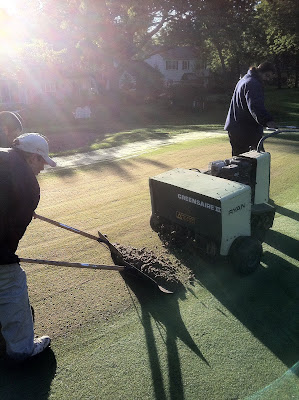Step 1: Core
The coring process is completed with one man walkers that must be guided across every square foot of the putting surface. These machines have multiple arms, that end in a total of twelve tines specially designed to remove material. Once driven in the ground they come up with small cylinders of turf, sand and soil called cores. These are then removed from the green by a a shoveling crew. This step is by far the most laborious and time consuming of the entire process.
Step 2: Topdress
Sand is spread heavily over the entire green. This is a type of sand meant especially to be used as a root zone. "But weren't we removing sand during our expansion project? Why are we putting it back in?" Yes, we were removing sand during the expansion. However, the sand we were removing was installed on mass in a single area. It was never amended and had no organic or soil content- which, in addition to the layering problem pure sand on clay caused- is why it eventually became a problem. The sand we are adding during this process is being added in small amounts across the entire green. Because of this the sand will work in conjunction with our soil profile and gain organic content from the layer of thatch that we have already established.
Step 3: Broom
The sand is then pushed into the holes through a process called brooming where a heavy duty broom is pulled behind a golf cart across the topdressing surface. Most holes will be filled by this process.
Step 4: Blow
Now we use a machine made up of a turbine with an attached nozzle to direct airflow to help force sand down into the open holes as well as to help open any holes that may have begun to collapse. This will also disperse any extra sand to other areas that might need it. Once We've made sure that all holes have been filled we will use the blower to evacuate all excess sand from the putting surface.
Step 5: Fertilize
Sometimes you have to be cruel to be kind (in the right measure), and even though the aerification process may offer a lot in the way of plant health long term, here and now damage is still being done. To help the turf heal and knit together through our aerification holes, we follow up the process with an application of fertilizer.
Step 6: Water!
Also applied to help the turf bounce back, but it also brings with it the ability to wash fertilizer into the soil profile where the roots can have access to it, as well as any remaining sand that may be left on the surface.
See you on the course!
Elliott Dowling


